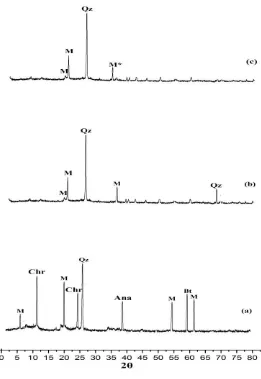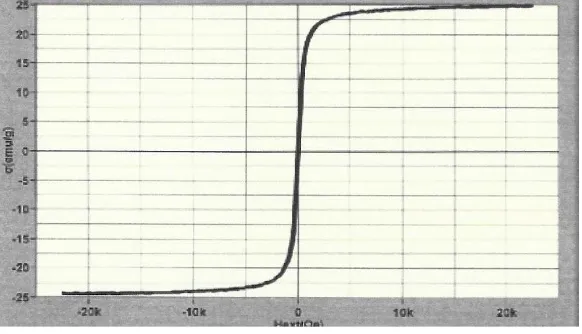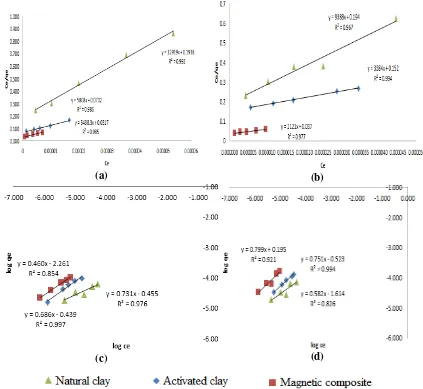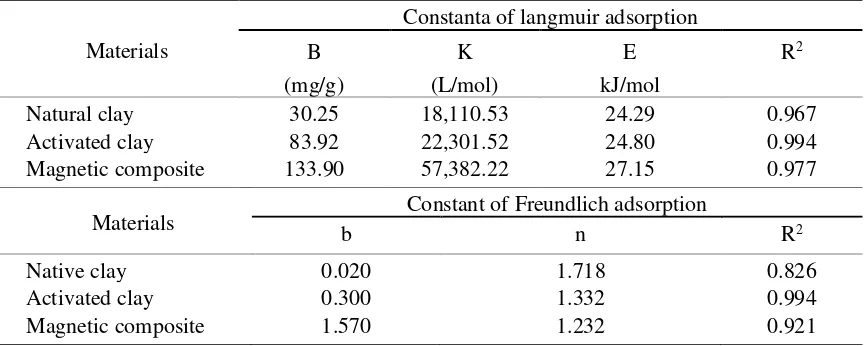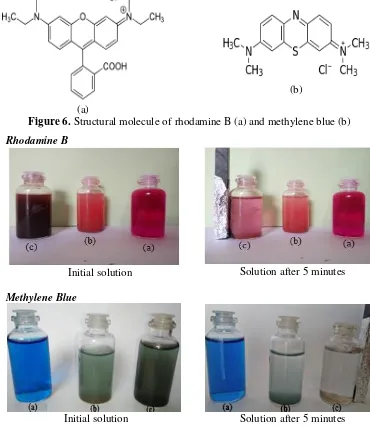Studies on Synthesis, Characterization, and Adsorption of Cationic Dyes from Aqueous Solutions Using Magnetic Composite Material from Natural Clay in
Central Kalimantan, Indonesia
I Made Sadiana, Karelius*, Retno Agnestisia, Abdul Hadjranul Fatah
Universitas Palangka Raya, Education Chemistry, Palangka Raya, Indonesia
*email: [email protected]
Received February 2, 2018; Accepted May 3, 2018; Available online May 31, 2018
ABSTRACT
Clay is a natural material from crystalline silicate with layered structures, has high cation exchange capacity, and large surface area. These advantages can be used as an adsorbent for the removal of contaminants in aqueous solutions, such as heavy metals and dyes. In Indonesia, clays from Java, Sulawesi, and Sumatra islands have been used as adsorbent, furniture, and construction materials. Due to limited information about basic characteristics of clay from Kalimantan, this clay has not been utilized well. Therefore, natural clay from Kalimantan, especially in Central Kalimantan, was used as adsorbent of cationic dyes in this present study. However, the clay has difficulty for separating the solid phase from aqueous solution after adsorption process. To solve this problem, combining clay with magnetic material was opted. The objectives of this study are to synthesize the magnetic composite material from natural clay by coprecipitation method and to characterize the synthesized magnetic composite material using an x-ray diffraction method, transmission electron microscopy, and vibrating sample magnetometer. The adsorption properties of the synthesized magnetic composite material were evaluated using rhodamine B and methylene blue dyes in aqueous solution. Before magnetic composite material was synthesized, the clay was previously being activated for removing impurities. The magnetic material formed in the structure of clay had magnetite with particle size of 2.75 nm and the magnetization value of 24.91emu/g. The adsorption capacities of natural clay, activated clay, and magnetic composite of clay in rhodamine B were 34.29, 76.27, and 81.46 mg/g, respectively, while in methylene blue were 30.25, 83.92, and 133.90 mg/g, respectively. These results suggested that magnetic composite of clay can increase the adsorption capacities against dyes and accelerate the separation of the adsorbent solid phase from aqueous solution with largest adsorption capacity on methylene blue dye.
Keywords: clay, magnetic composite, coprecipitation, adsorption, and cationic dye.
INTRODUCTION
Clay is a natural material from crystalline silicate with layered structures. Clay has particle size less than 2 μm (Ortega, Ramos, & Flores-Cano, 2013). After Java and Sumatra, huge natural clay reserves (8.9 million m3) were obtained in Central Kalimantan, Indonesia (Amarullah et al., 2002). The clay has high cation exchange capacity, large surface area, and structural stability (Ortega et al., 2013). These characteristics can be applied as adsorbent for removing contaminants in aqueous solutions, such as Cd(II)-Ni(II) (Ortega et al., 2013), Cu(II) and Zn(II) (Musso, Parolo, Pettinari, & Francisca, 2014), Cr(VI) (Zhao, Qi, Chena, & Zhang, 2015), Pb(II) (Georgescu, Nardou, Zichil, & Nistor, 2017), uranium (Gładysz-Płaska, Grabias, & Majdan, 2017), phosphate ions (Sinta, Suarya, & Santi, 2015), ammonium ions (Alshameri, He, Zhu, Xi, & Tao, 2017), essential oils (Nakhli et al., 2018), basic red 46 and direct blue 85 (Santos & Boaventura, 2016), and methylene blue,
crystal violet, and congo red (Bentahar, Dbik, El Khomri, El Messaoudi, & Lacherai, 2017). The results showed that the clay has good ability to remove those contaminants, although the adsorption capacities were higher in dyes than others.
Debacher, 2014; Chen, Zhou, Fiore, Tong, & Yu, 2016). As a type of magnetic material, iron oxide (Fe3O4) can be composed in the clay (Chen et al., 2016). It forms a ferromagnetic regularity with the highest magnetization saturation (Ms) value was 92 emu/g (Cullity, 1972). The synthesizing of magnetic composite material can be conducted by coprecipitation methods (Lee, Jeoung, Shin, Kim, & Kim, 2004; Wu et al., 2012; Liu, Chen, Liu, Liu, & Dong, 2014; Chang et al., 2016).
Rhodamine B and methylene blue are widely used in the textile industry. These compounds are cationic dyes. In the dyeing process, only 5% of dyes are used, the rest 95% will be discharged in water as a waste (Purwamargapratala, Yusuf, & Ridwan, 2013). These dyes are toxic and nondegradable, thus inapproppiate waste management will result negative impacts to environment and human health (Purwamargapratala., 2013). Based on these considerations, studies on synthesis, characterization, and adsorption of cationic dyes using magnetic composite material from natural clay in Central Kalimantan, Indonesia were conducted. This research was expected to increase the added value of natural clay and to decrease dye pollutions.
MATERIAL AND METHODS
Materials
The natural clay was obtained from Central Kalimantan, Indonesia. Rhodamine B (C.I no. 45170; C.I. name, basic violet 10; C28H31ClN2O3; 479.02 g/mol), and methylene blue (C.I no. 61734; C.I. name, Basic blue 9; C16H18ClN3S; 319.851 g/mol) were purchased from Malang, Indonesia. Analytical grade FeCl3·6H2O, FeSO4·7H2O, NH4OH, AgNO3, HCl, and NaOH were obtained from Merck, Tbk. All solutions were prepared using distilled water.
Preparation of natural clay
The natural clay was cleaned from rough impurities and then heated using an oven at 70°C for 3 hours. In addition, the clay was crushed and filtered with a 60 µm nylon mesh. The natural clay was characterized using an x-ray diffraction (XRD) method.
Activation of natural clay
Fifty grams of native clay were refluxed with 250 mL of HCl 3 M for 3 hours at 100°C. The clay was filtered and washed with distilled
water, and then chlorine tested using AgNO3. The solid of clay was dried at 100 °C for 3 hours. After drying, the clay was crushed and filtered with a 60 µm nylon mesh. In addition, this clay was calcined using furnace at 500 °C for 3 hours. The activated clay was characterized using the XRD method.
Synthesis of magnetic composite material The coprecipitation method was used to synthesize the magnetic composite material. Firstly, FeSO4·7H2O and FeCl3·6H2O solutions were prepared in 100 mL with concentrations of 0.025 M and 0.050 M, respectively. The two solutions were mixed with 2 grams of activated clay, and then were stirred at 85 °C, while NH4OH solution was also added to achieve stable pH at 10. This suspension was air-dried for 3 hours. Finally, the magnetic composite materials could be seperated using an external magnetic field. This composite material was washed with distilled water and dried for 2 hours at 110 °C. Furthermore, the composite was crushed and filtered with a 60 µm nylon mesh. The XRD method, transmission electron microscopy (TEM), and vibrating sample magnetometer (VSM), were used to characterize the composite material.
Adsorption test
Natural, activated, and magnetic composite clays were used to adsorb the 10, 20, 30, 40, and 50 ppm of rhodamine B and methylene blue solutions at both pH of 2 and 4. The use of 2 and 4 pH was considered based on the optimum condition adsoption as obtained in the previous research (data is not shown). The processes were conducted using a shaker at room temperature for 3 hours. Concentration of rhodamine B and methylene blue in aqueous solution were measured using a UV-Vis spectrophotometer.
Separation test
The adsorbents of activated clay and magnetic composite material were added to rhodamine B and methylene blue solutions. These suspensions were then shaken at room temperature for 60 min. Finally, from these suspensions, the adsorbents were seperated using an external magnetic field.
RESULTS AND DISCUSSION
The synthesize of magnetic composite materials from natural clay was conducted with Fe2+ and Fe3+ solutions at mole ratio of 1:2 and 85°C. These Fe2+ and Fe3+ ions entered into the structure of clay by ion exchange processes. In addition, Fe2+ and Fe3+ ions within structure of clay formed Fe(OH)2 and Fe(OH)3 due to the addition of NH4OH
solution. Fe(OH)2 and Fe(OH)3 were oxidized and became magnetite (Fe3O4) particles in the structure of clay. The natural, activated, and magnetic composite material clays were verified using an XRD instrument. The x-ray difractogram for natural clay, activated clay and magnetic composite material clay are shown in Figure 1.
Figure 1. Difractogram of natural clay (a), activated clay (b), and magnetic composite material (c) (M = monmorilonite, Chr = chrysotile, Qz = quartz, Olg = oligoclase, Bt = biotite, M* = magnetite).
a b c
Based on the Joint Comitte on Powder Difraction (JCPDS) standard, showing that the natural clay contained minerals of monmorilonite
((Si7,8Al0,2)IV(Al3,4Mg0,6)VIO20(OH)4), chrysotile (Mg3Si2O5(OH)4), kuarsa (SiO2), anatase
(TiO2), and biotite
(K(Mg,Fe)3(Al,Fe)Si3O10(OH,F)2)). The difractogram in Figure 1(a) and 1(b) showed that the peaks of chrysotile, anatase, and biotite in the clay disappeared after the activation processes. These results suggest that activation could remove impurity minerals, such as crysotile, oligoclase, and biotite. In Figure 2(c), the diffractogram also showed a change in the diffraction patterns of the magnetic composite material with showing a new peak at 35.35°. This peak showed magnetite (Fe3O4) particles, which also were indicated by blackish colored of magnetic composite material as shown in Fig. 2b.
Figure 2(c) showed that the magnetic composite material had magnetic property
because it was attached to an external magnetic field. This magnetic property was needed to facilitate the separation process between the clay and liquid phase after the adsorption process. The magnetization value of the composite material also is investigated using the VSM instrument. The result was presented as the hysteresis curve (Figure 3). The formed magnetic composite material was superparamagnetic with a magnetization value at 24.91emu/g.
The micro structural image of magnetic composite material was presented in Fig. 4. Figure 4 showed that magnetic composite material has a similar size and morphology. The particle image of the TEM is then measured with the J image software. The result
show that the synthesize of magnetic
composite material using the coprecipitation method produced about 2.75 nm of particle size. Smaller particle size would produce larger surface areas that benefit to increase the adsorption capacities of cationic dyes.
Figure 3. Hysteresis curve of magnetic composite
(a) (b)
(c) (d)
Figure 5. Curves of Langmuir isotherm on rhodamine B (a), Langmuir isotherm on methylene blue (b), Freundlich isotherm on rhodamine B (c), and Freundlich isotherm on methylene blue (d) Mechanisms, capacity, and energy
adsorptions for two cationic dyes
The clay contained mineral of monmorilonite. This mineral has active site that can be used to adsorb the cationic dyes, such as rhodamine B and methylene blue (Bentahar et al., 2017). The results of adsorption in this study were tested using Langmuir and Freundlich isotherm models to determine the mechanisms of adsorption, adsorption capacity, and adsorption energy of adsorbents on rhodamine B and methylene blue dyes. Based on the linear regression value, the active sites in the adsorbents were homogeneous, indicating that a molecule of rhodamine B and methylene blue would attach to each an active site. The obtained higher correlation coefficients for the Langmuir model predicted that the range of rhodamine B and methylene blue molecules were monolayer
with mechanism of chemical adsorption. The Langmuir isotherm pattern can also determine the value of adsorption capacity (B) of the adsorbents as shown in Tables 1 and 2.
as the active site of clay which can be used as an adsorbent to adsorb the cationic dyes, such as rhodamine B and methylene blue by electrostatic force (Bentahar et al., 2017) In
addition, the activation process was also able to dissolve the impurities and open the hidden site, so that can increase the active site of clay (Trabelsi & Tlili, 2017).
The addition of magnetite particles into the clay structure also can increase the adsorption capacities. The inclusion of magnetite particles into the interlayer of monmorillonite mineral of clay would form a two-dimensional porous material with a large surface area. The formed oxides between the layers are permanent and functioned as buffers between the layers (Hutson, Hoekstra, & Yang, 1999), thus it allows rhodamine B and methylene blue molecules to enter to the interlayer spaces and are bonded on the active sites of monmorillonite minerals of clay. The adsorption also can occur due to electrostatic force between oxygen atoms from magnetite that have a negative-partial charge with the positive-partial charge from rhodamine B and
methylene blue molecules. Another possibility would be a coordinate covalent bond between magnetite and molecules dye. The oxygen atoms of magnetite have free electrons pairs that can be donated to group of dyes that have an empty orbital, and then these pairs of electron are used together to form a coordinate covalent bond.
The data in Tables 1 and 2 also showed that methylene blue molecules were mostly adsorbed in the activated clay and magnetic composite material. This result was caused by the smaller molecular size of methylene blue than that of rhodamine B (Figure 6). The smaller molecular sizes would result in more easily bind to the active sites of adsorbents.
Table 1. Constant values of isotherm adsorption for rhodamine B
Materials
Constant of Langmuir adsorption
B K E R2
(mg/g) (L/mol) kJ/mol
Natural clay 34.29 67,994.83 27.57 0.993
Activated clay 76.27 83,056.48 28.06 0.986
Magnetic composite 81.46 175,315.57 29.91 0.985
Materials b Constant of Freundlich adsorption n R2
Natural clay 0.350 1.368 0.976
Activated clay 0.360 1.458 0.997
Magnetic composite 0.010 2.173 0.854
Table 2. Constant of isotherm adsorption for methylene blue
Materials
Constanta of langmuir adsorption
B K E R2
(mg/g) (L/mol) kJ/mol
Natural clay 30.25 18,110.53 24.29 0.967
Activated clay 83.92 22,301.52 24.80 0.994
Magnetic composite 133.90 57,382.22 27.15 0.977
Materials b Constant of Freundlich adsorption n R2
Native clay 0.020 1.718 0.826
Activated clay 0.300 1.332 0.994
The application of the Langmuir isotherm equation can be developed to determine the adsorption energy, according to the equation of E = RT ln K. Based on calculation using this equation, the values of adsorption energy for rhodamine B and methylene blue in the three types of adsorbent exceeded 20 kJ/mol (as shown in Tables 1 and 2). These results suggest that the bonds between the active sites of adsorbent with cationic dyes are chemical bonding. The adsorption between the clay and dyes occurs by the electrostatic forces. While, the adsorption between the magnetic composite of clay and dyes occurs by electrostatic forces and coordinate covalent bond.
Separation test of adsorbents in dye solutions
The activated clay and magnetic composite
of clay were used in this study to
investigate separation test. After these
adsorbents were used in the adsorption
processes, they were separated from the
aqueous solutions. The activated clay
adsorbent was separated by sedimentation
using force of gravity, while an external
magnetic field was used to seperate the
magnetic composite material adsorbent
from the solutions (
Figure 7
).
(a)
(b)
Figure 6. Structural molecule of rhodamine B (a) and methylene blue (b)
Rhodamine B
Initial solution Solution after 5 minutes
Methylene Blue
Initial solution Solution after 5 minutes
CONCLUSION
The magnetic material formed in the structure of clay had magnetite with the magnetization value of 24.91emu/g. The adsorption capacities of natural clay, activated clay, and magnetic composite of clay in rhodamine B were 34.29, 76.27, and 81.46 mg/g, respectively, while in methylene blue were 30.25, 83.92, and 133.90 mg/g, respectively. These results suggested that magnetic composite of clay can increase the adsorption capacities against dyes and accelerate the separation of the adsorbent solid phase from aqueous solution with largest adsorption capacity on methylene blue dye. ACKNOWLEDGEMENT
The authors were grateful for financial support from DRPM DIKTI through the Grant of Applied Products in 2017.
REFERENCES
Amarullah, D., Margani, U., Saksono, Priatna, Priono, & Sudiro. (2002). Inventarisasi dan evaluasi endapan batubara kabupaten Barito Selatan dan Barito Utara Provinsi Kalimantan Tengah. Kolokium Direktorat Inventarisasi Sumber Daya Mineral, (DIM) TA, 20, 1-14.
Alshameri, A., He, H., Zhu, J., Xi, Y., & Tao, Q. (2017). Adsorption of ammonium by different natural clays minerals: Characterization, kinetics and adsorption isotherms. Applied Clay Science. In press, corrected proof.
Bentahar, S., Dbik, A., El Khomri, A., El Messaoudi, N., & Lacherai, A. (2017). Adsorption of methylene blue, crystal violet and congo red from binary and ternary systems with natural clay. Kinetic, isotherm, and thermodynamic. Journal of Environmental Chemical Engineering, 5, 5921-5932.
Chang, J. L., Ma, J. L., Zang, D. D., Qiao, N. N., Hu, M. X., & Ma, H. J. (2016). Adsorption of methylene blue onto Fe3O4/activated montmorillonite nanocomposite. Applied Clay Science, 119, 132-140.Chen, L., Zhou, C, H., Fiore, S., Tong, D, S., & Yu, W, H. (2016). Functional magnetic nanoparticle/clay mineral nanocomposites: preparation, magnetism
and versatile applications. Applied Clay Science, 127–128, 143-163.
Cottet, L., Almeida, N. Naidek, M.F. Viante, & Debacher. (2014). Adsorption characteristics of montmorillonite clay modified with iron oxide with respect to methylene blue in aqueous media. Applied Clay Science, 95, 25-31.
Cullity, B. D. (1972). Introduction to Magnetic Materials. London: Addison Esley Publishing Company.
Georgescu, A., Nardou, F., Zichil, V., & Nistor. I. (2018). Adsorption of lead(II) ions from aqueous solutions onto Cr-pillared clays. Applied Clay Science, 152, 44-50. Gładysz-Płaska, A., Grabias, E., & Majdan, M. (2017). Simultaneous adsorption of uranium(VI) and phosphate on red clay. calcination temperature and clay cation exchange capacity. Microporous and Mesoporous Materials, 28, 447- 459. Koyuncu, H. (2007) Adsorption kinetics of
3-hydroxybenzaldehyde on native and activated bentonite. Applied Clay Science, 38, 279–287.
Lee, S. J., Jeoung, J. R., Shin, S.C., Kim, J. C & Kim, J. D. (2004). Synthesis and characterization of superparamagnetic magnetite nanoparticles prepared by Coprecipitation Technique. Magnetism, Magnetic Mater, 282, 147-150.
Liu, H. C., Chen, W., Liu, C., Liu, Y., & Dong, C. L. (2012). Magnetic mesoporous clay adsorbent: preparation, characterization and adsorption capacity for atrazine. Microporous and mesoporous, 194, 72-78.
Musso, Parolo, Pettinari & Francisca, F. (2014). Cu(II) And Zn(II) adsorption capacity of three different clay liner materials. Journal of Environmental Management, 146, 50-58.
Ortega, E., Ramos & Flores-Cano. (2013). Binary adsorption of heavy metals from aqueous solution onto natural clays. Chemical Engineering Journal, 225, 535–546.
Purwamargapratala, Y., Yusuf, S & Ridwan. (2013). Degradasi metilen biru dengan komposit TiO2SiO2Fe3O4. Prosiding Seminar Nasional IX SDM Teknologi Nuklir. Yogyakarta, Indonesia: ISSN 1978-0176.
Santos, R., & Boaventura. (2016). Adsorption of cationic and anionic azo dyes on sepiolite clay: Equilibrium and kinetic studies in batch mode. Journal of Environmental Chemical Engineering, 4, 1473–1483.
Sinta, I, N., Suarya, P, & Santi. (2015). Adsorpsi ion fosfat oleh lempung
teraktivasi asam sulfat (H2SO4). Jurnal Kimia, 2, 217-225.
Trabelsi, W., & Tlili, A. (2017). Phosphoric acid purification through different raw and activated clay materials (Southern Tunisia). Journal of African Earth Sciences, 129, 647-658.
Wu, D., Zhu, C., Chen, Y., Zhu, B., Yang, Y., Wang, Q., & Ye, W. (2012). Preparation, characterization and adsorptive study of rare earth ions using magnetic GMZ bentonite. Applied Clay Science, 62, 87-93.
